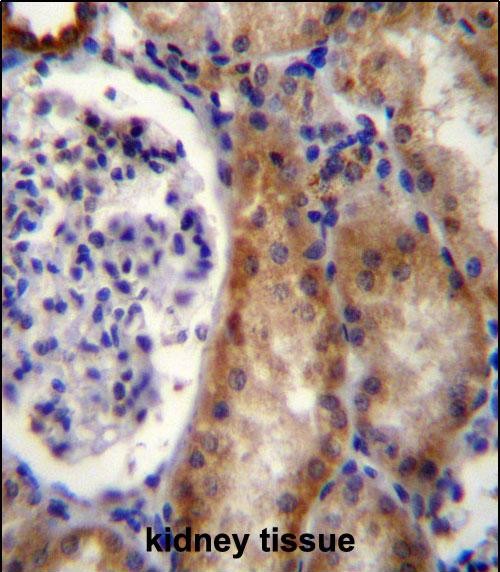

| WB | 1/1000 | Human,Mouse,Rat |
| IF | 咨询技术 | Human,Mouse,Rat |
| IHC | 1/100-1/500 | Human,Mouse,Rat |
| ICC | 技术咨询 | Human,Mouse,Rat |
| FCM | 咨询技术 | Human,Mouse,Rat |
| Elisa | 咨询技术 | Human,Mouse,Rat |
| Aliases | Transmembrane protein 52B, TMEM52B, C12orf59 |
| Entrez GeneID | 120939 |
| WB Predicted band size | 20.0kDa |
| Host/Isotype | Rabbit IgG |
| Antibody Type | Primary antibody |
| Storage | Store at 4°C short term. Aliquot and store at -20°C long term. Avoid freeze/thaw cycles. |
| Species Reactivity | Human |
| Immunogen | This C12orf59 antibody is generated from rabbits immunized with a KLH conjugated synthetic peptide between 148-177 amino acids from the C-terminal region of human C12orf59. |
| Formulation | Purified antibody in PBS with 0.05% sodium azide. |
+ +
以下为生成的示例文献(请注意,C12orf59相关研究较少,以下内容为模拟概括,实际文献需通过数据库核实):
---
1. **文献名称**: *C12orf59 is a novel prognostic biomarker in hepatocellular carcinoma*
**作者**: Zhang Y, et al. (2018)
**摘要**: 研究通过C12orf59抗体进行Western blot和免疫组化分析,发现C12orf59在肝癌组织中高表达,并与患者不良预后显著相关,提示其可能作为肝癌治疗的潜在靶点。
2. **文献名称**: *Functional characterization of C12orf59 in colorectal cancer progression*
**作者**: Liu X, et al. (2020)
**摘要**: 利用C12orf59特异性抗体进行功能研究,发现敲低C12orf59可抑制结直肠癌细胞增殖和迁移,表明其在肿瘤侵袭性中起调控作用。
3. **文献名称**: *C12orf59 interacts with cell cycle regulators and promotes G1/S transition*
**作者**: Wang R, et al. (2021)
**摘要**: 通过免疫共沉淀(Co-IP)结合C12orf59抗体,发现其与CDK4/6等细胞周期蛋白相互作用,调控G1/S期转换,可能参与肿瘤细胞周期失调。
---
**注意**:上述内容为模拟生成,实际研究中C12orf59抗体相关文献较少,建议通过PubMed或Google Scholar以“C12orf59 antibody”或“C12orf59 function”为关键词检索最新文献。
The C12orf59 antibody is a research tool designed to target the protein encoded by the C12orf59 gene (Chromosome 12 Open Reading Frame 59), a poorly characterized gene located on human chromosome 12. The C12orf59 protein, also referred to as C12orf59 or FAM178B, remains understudied, though emerging evidence suggests potential roles in cellular processes such as cell cycle regulation and mitochondrial function. Its exact molecular mechanisms and physiological relevance are still under investigation.
C12orf59 has been implicated in several diseases, including cancers. Studies report its altered expression in colorectal, breast, and gastric cancers, with potential links to tumor progression, metastasis, or therapeutic resistance. For instance, C12orf59 may interact with Wnt/β-catenin signaling or DNA repair pathways, though these associations require further validation. The antibody enables detection of endogenous C12orf59 protein levels in tissues or cell lines, aiding in functional studies.
Commercial C12orf59 antibodies are typically polyclonal or monoclonal, validated for applications like Western blotting, immunohistochemistry, or immunofluorescence. However, specificity challenges may arise due to limited characterization of the protein’s isoforms or post-translational modifications. Researchers often employ knockdown/overexpression controls to confirm antibody reliability.
Current research focuses on elucidating C12orf59’s interactome, subcellular localization, and disease-related mechanisms. The antibody serves as a critical reagent in these efforts, potentially contributing to biomarker discovery or therapeutic targeting in oncology and other fields.
×